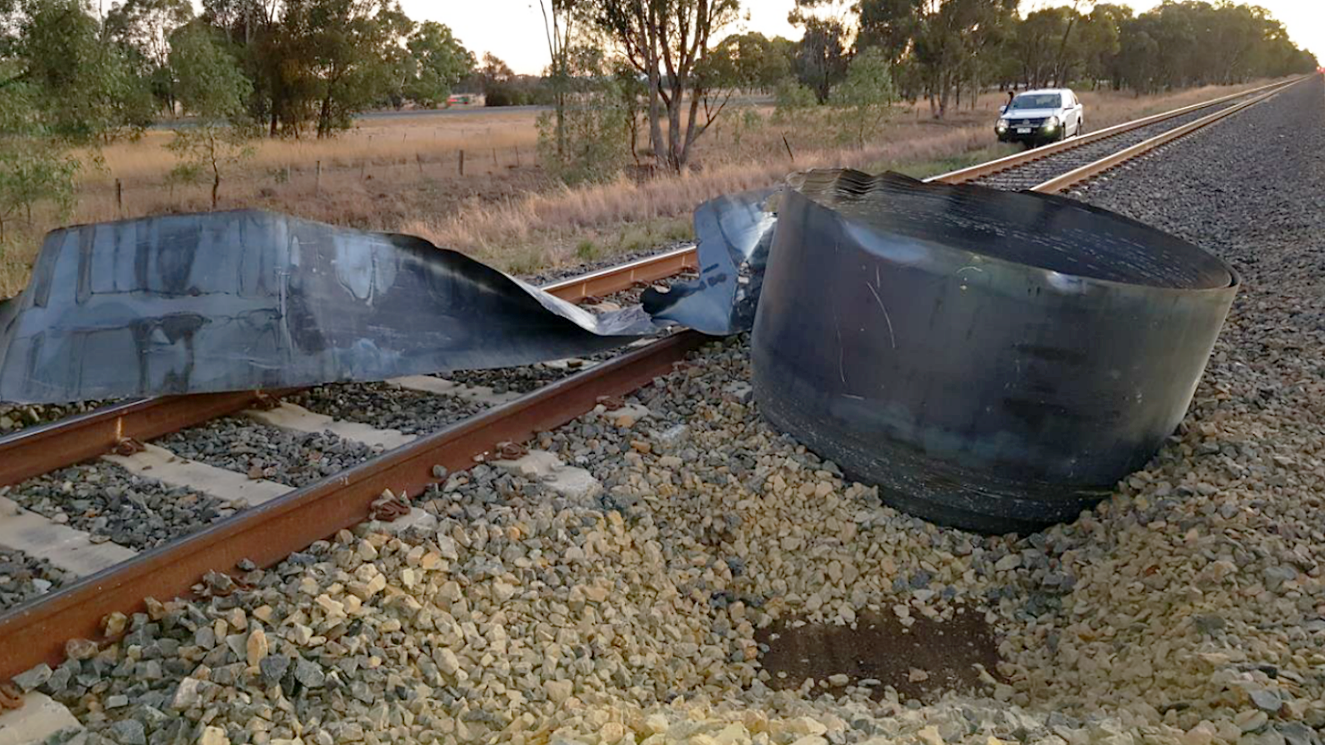
|
Key points:
|
A passenger train had begun making an emergency braking application when it struck the tail of a steel ‘jumbo’ coil which was obstructing rail track in both directions on the Sydney-Melbourne main line near Winton, Victoria on 30 March 2018, after the coil had dislodged from a freight train, a new ATSB investigation report notes.
The Melbourne to Albury V/Line passenger train service was travelling at about 110 km/h when it struck the unrolled tail of the 1.9 metre diameter, 16 tonne coil of rolled steel.
The coil had fallen from the 35th wagon of a Pacific National freight train, which was travelling from Port Kembla to Melbourne with a consignment of steel products from Blue Scope Steel, after passing the Seven Mile Creek Bridge near Winton. After falling from the wagon, the coil impacted ballast between the tracks at least twice, misaligning the east and west tracks, and damaging 39 trailing wagons (including damage to steps, handbrakes, brake cylinders and bearing caps), before coming to rest between the two tracks.
About 10 minutes later, the V/Line passenger service, which was travelling in the opposite direction, impacted the unravelled tail of the coil and entered the damaged track, but did not derail.
Two train crew members standing in the buffet car were thrown sideways as the train traversed the damaged tracks, sustaining minor injuries. The train’s locomotive received superficial damage.
“While no injuries to passengers were reported, this investigation highlights the importance of robust load restraint systems to protect against movement of loads during transport, which is particularly important for heavy loads,” said ATSB Director Transport Safety Dr Stuart Godley.
“Should heavy loads like jumbo coils fall from train wagons they pose a significant risk to the safety of passengers and train crew of other rail vehicles.”
After striking the coil, the driver brought the passenger train to a stop, and advised train control that they had struck a steel coil. After applying signal blocks to both tracks, train control requested the drivers of the freight train to stop and inspect their train.
The subsequent ATSB investigation into the incident found that the coil had likely fallen from the wagon due to the absence of a rubber mat from one of the two faces of the cradle that supported the coil. The mat’s absence meant some of the coil’s metal unitising securing straps were in direct metal-to-metal contact with the cradle, increasing the risk of the straps failing, and allowing the coil centre to telescope (where the inner rolls of the coil move laterally relative to the outer layers). This reduced the coil’s lateral stability, and increased the risk of it falling from the cradle.
While it could not be conclusively determined when the straps broke it was likely that at least some broke during transit, reducing the ability of the remaining straps to maintain the coil as a unit. Subsequently, the remaining straps either also broke due to the forces imposed on them or were insufficient to prevent the coil from telescoping. Two broken steel straps were found either side of the track where the coil had fallen from the train.
Photographic evidence showed that the mat had been missing from the wagon's cradle since at least June 2017.
“The missing mat resulted in steel-on-steel contact between the coil and the cradle,” said Dr Godley.
“This increased the likelihood of wear on the coil’s securing straps, particularly if the radial straps were positioned within the contact area, which was permitted by the operator’s loading rules. Consequently, the risk of securing straps breaking during the journey was increased.”
Since the incident, a number of actions have been taken to reduce the risk of a similar occurrence, the ATSB investigation report notes. These include Pacific National updating their freight loading manual to require the use of a minimum of two radial and two circumferential straps to secure coils. The operator also updated its wagon maintenance manual to include a requirement to 'consider the condition of load mats during inspection and maintenance', and to repair or replace as required.
However, the ATSB has identified two safety issues from the investigation that remain unaddressed, and so has issued two formal safety recommendations to Pacific National. The first recommendation concerns the risk presented by continuing to allow the loading of jumbo coils in such a way that radial securing straps can contact the wagon’s support cradle. The second concerns ensuring that cradles sufficiently restrain jumbo coils against lateral accelerations to prevent their moving and falling during transit.
“Load restraint systems should include assessments and documentation that demonstrate appropriate load cases, design requirements, operational and loading requirements have been met, to ensure that the safety of the load restraint is maintained over time,” said Dr Godley.
Read the final report: Track obstruction due to loss of freight involving train 6WM2 and subsequent impact of passenger train 8615 with track obstruction, near Winton, Victoria, on 30 March 2018


